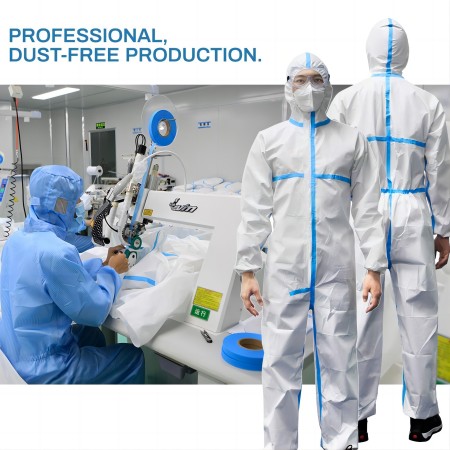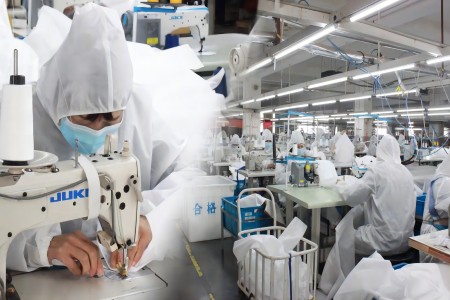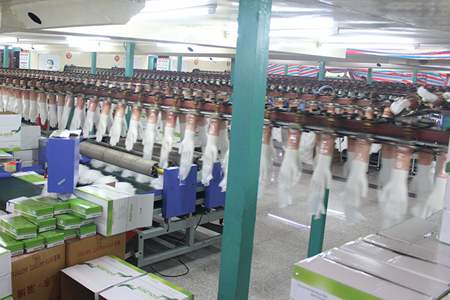2023/9/21

How Disposable Coveralls are Made
Disposable coveralls are an essential component in personal protective equipment for individuals working in hazardous environments. They are designed to protect the wearer from exposure to hazardous materials, chemicals, and infectious agents. These coveralls are made using a complex manufacturing process that involves several stages, from selecting the right raw materials to designing and cutting the fabric. In this article, we'll take you through a step-by-step guide on how disposable coveralls are made, giving you an in-depth understanding of the intricate process involved in creating these protective garments.
Raw materials used in disposable coverall production
The first step in creating disposable coveralls is selecting the right raw materials. The materials used in the production of these coveralls must be lightweight, breathable, and durable. The most commonly used materials for disposable coveralls are non-woven fabrics made from polypropylene. These fabrics are spunbonded to create a durable and breathable material that can protect the wearer from hazardous materials.
The raw materials are sourced from manufacturers who produce non-woven fabrics. The fabrics are then tested for quality before being purchased for use in coverall production. Once the raw materials have been selected, they are transported to the manufacturing facility.
At the manufacturing facility, the raw materials are inspected again for any defects or impurities. The materials are then loaded onto machines that will transform them into coveralls. The process of making disposable coveralls starts with the design and pattern-making.
Design and pattern-making for disposable coveralls
Design and pattern-making are critical components of the manufacturing process. The design must be functional and comfortable for the wearer while providing adequate protection. The pattern is created using specialized computer software that takes into account the size and shape of the wearer. The pattern is then printed onto paper and used to cut the fabric.
The pattern is carefully placed onto the non-woven fabric, and a cutting machine cuts the fabric to the exact shape of the pattern. The cut fabric is then ready for sewing.
Cutting and sewing the coveralls
The next step in the manufacturing process is sewing the coveralls. The sewing process is done using specialized machines that can quickly stitch the fabric together. The machines are programmed to sew the fabric together in specific patterns, ensuring that the coveralls are sewn correctly every time.
Once the coveralls are sewn, they are inspected for any defects or imperfections. Any coveralls that do not meet the quality standards are discarded, and the process starts again.
Quality control and testing
Quality control is an essential component of disposable coverall production. The coveralls must meet specific quality standards to ensure that they provide the necessary protection to the wearer. To ensure quality, the coveralls are tested for strength, breathability, and resistance to hazardous materials.
The coveralls are tested using specialized machines that simulate real-life conditions. For example, the coveralls may be exposed to hazardous materials to test their resistance. The coveralls are also tested for their breathability to ensure that they are comfortable for the wearer.
Sterilization and packaging
Once the coveralls have been tested and approved, they are ready for sterilization and packaging. Sterilization is necessary to ensure that the coveralls are free from any harmful bacteria or viruses. The coveralls are sterilized using specialized equipment that kills any bacteria or viruses present on the fabric.
After sterilization, the coveralls are packaged in a sterile environment to ensure that they remain free from contamination. The packaging is designed to be easy to open and use, ensuring that the coveralls are accessible when needed.
Distribution and sales
The final step in the process is distribution and sales. The coveralls are transported to distributors who sell them to end-users. The distributors must ensure that the coveralls are stored and transported correctly to maintain their quality.
The coveralls are sold in various sizes to ensure that they fit all individuals. They are also available in different levels of protection, depending on the specific hazards that the wearer will be exposed to.
Conclusion
Disposable coveralls play a critical role in protecting individuals working in hazardous environments. The manufacturing process involved in creating these coveralls is complex and involves several stages, from selecting the right raw materials to designing and cutting the fabric. Each stage requires precision and attention to detail to ensure that the coveralls meet the necessary quality standards. With this step-by-step guide, you now have an in-depth understanding of how disposable coveralls are made.
Hefei Haoxin Protective is one of the renowned disposable coverall manufacturers in China. With a specialization in producing various types of disposable coveralls, we take pride in our products' top-notch quality and competitive prices. Our dedication to meeting international standards is evident through our FDA and CE certifications. These certifications ensure that our coveralls adhere to strict safety and quality guidelines. Whether you are in the medical, industrial, or any other sector requiring reliable protective clothing, Hefei Haoxin Protective is your trusted partner. Choose us for exceptional disposable coveralls that provide optimal protection and peace of mind.




 WhatsApp
WhatsApp
Send us your message
You can send an email asking for the price and detailed information of this product. We will reply you as soon as we receive your email